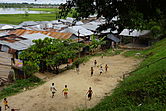Itaya River
| Itaya River Río Itaya | |
|---|---|
 A view of the Itaya River from the city of Iquitos | |
| Location | |
| Country | Peru |
| City | Iquitos |
| Physical characteristics | |
| Mouth | |
• coordinates | 3°42′0″S 73°15′0″W / 3.70000°S 73.25000°W |
| Length | 213 km (132 mi) |
| Basin size | 2,668 km2 (1,030 sq mi) 2,530 km2 (980 sq mi)[1] |
| Discharge | |
| • location | Iquitos (near mouth) |
| • average | 153.27 m3/s (5,413 cu ft/s) 108 m3/s (3,800 cu ft/s)[2] |
| Basin features | |
| River system | Amazon Basin |
The Itaya River is a tributary of the Amazon River via the Nanay River[citation needed] in northern Peru. The Itaya flows alongside the city of Iquitos and the district of Belén.
In Iquitos, a riverwalk and breakwater called Malecón Tarapacá overlooks the Itaya.[3] To the north of Malecón Tarapacá is Malecón Maldonado.[3]
The Itaya River is the namesake of the fan palm genus Itaya, which was first discovered on the river's bank.[4]
The 2012 floods of the Amazon, Itaya, and Nanay Rivers, amid the heaviest rains the region had endured in 40 years, left approximately 80,000 people homeless.[5] In April 2015, 11 hours of steady rain swelled the Itaya again, causing the Iquitos–Nauta highway to collapse at four points: kilometres 22, 22.2, 23, and 26.[6]
See also
[edit]References
[edit]- ^ "Oficina Nacional de Evaluación de Recursos Naturales (ONERN)". 1980.
- ^ "Oficina Nacional de Evaluación de Recursos Naturales (ONERN)". 1980.
- ^ a b "Malecón Tarapacá". MINCETUR. San Isidro: Ministry of Foreign Commerce and Tourism (Peru). Retrieved 2016-04-07.
- ^ Piptocarpha (Compositae: Vernonieae). Flora Neotropica. New York: New York Botanical Garden Press. 2007. p. 51. ISBN 978-0-89327-482-5. OCLC 77504368.
- ^ "Inundaciones afectan a unos 80 mil pobladores" [Flooding affects some 80,000 poor]. Perú.21 (in Spanish). 7 April 2012. Archived from the original on 2014-07-31. Retrieved 2016-04-07.
- ^ "Loreto: Colapsó la carretera Iquitos-Nauta por crecida del río Itaya" [Loreto: Iquitos-Nauta highway collapsed by swelling of the Itaya River]. Perú.21 (in Spanish). 2 April 2015. Retrieved 2016-04-07.
External links
[edit] Media related to Itaya River at Wikimedia Commons
Media related to Itaya River at Wikimedia Commons- Arellano Valdivia, Juan (4 April 2012). "La creciente del Amazonas y las inundaciones en Loreto" [The rising of the Amazon and the floods in Loreto]. Globalizado (in Spanish).
3°42′45″S 73°13′57″W / 3.7125°S 73.2324°W
Text is available under the CC BY-SA 4.0 license; additional terms may apply.
Images, videos and audio are available under their respective licenses.



